14 Winter-Blooming Houseplants That Will Brighten the Season's Short Days
- Oops!Something went wrong.Please try again later.
These beautiful plants will add color and warmth to your home.
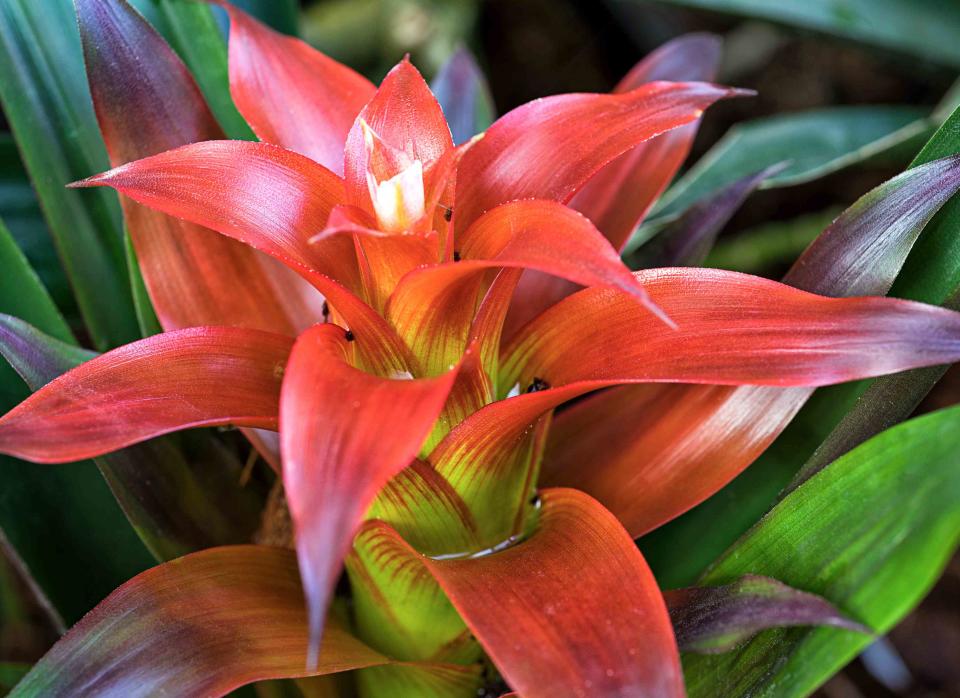
Petchjira / Getty Images
Winter can be a hard time for gardeners—the last blooms of the year begin to die back, bulbs are moved indoors to overwinter, and many trees lose their lush foliage. Even if you live in an area where winters are warmer, the shorter days and fewer hours of sunlight likely leave you with less time to tend to your garden. But you can still enjoy the colors of a spring and summer garden by adding a few winter-blooming houseplants to your collection. These colorful plants, like bird of paradise and moth orchid, produce blooms in winter when cared for properly, giving you something to admire while you wait for warmer weather to return.
Meet the Expert
Justin Hancock, horticulturist for Costa Farms
Melinda Myers, gardening expert and host of the Great Courses How to Grow Anything DVD series
Related: Winter Garden Prep Keeps Your Landscape Healthy Throughout the Season—Here's How to Do It
Holiday Cactus
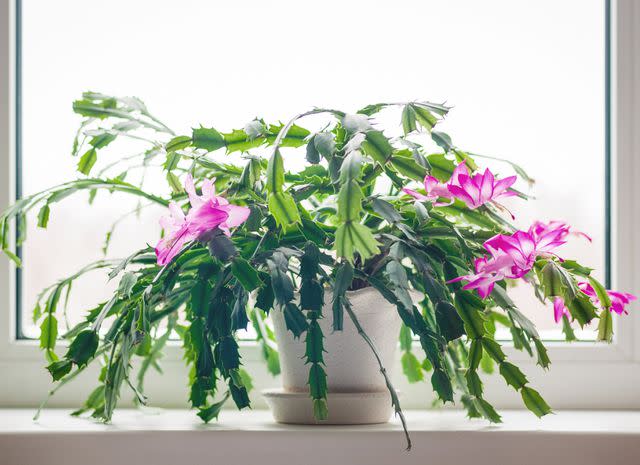
Nadya So / Getty Images
There are three types of holiday cactus (Schlumbergera spp.)—Christmas, Easter, and Thanksgiving. "Unlike a lot of desert cacti, holiday cacti are epiphytes, meaning that instead of growing on the ground, they grow on tree limbs," says Justin Hancock, horticulturist for Costa Farms. "They have green, flattened stems, often with toothed margins and lovely flowers in shades of yellow, peach, orange, red, pink, purple, or white." The flowers usually appear during the coolest months of the year and last four to six weeks.
Size: 12 inches tall x 24 inches wide
Growing conditions: Bright light; well-draining soil
Related: How to Care for a Thanksgiving Cactus, a Houseplant That Blooms in Tandem With the Holiday
Anthurium
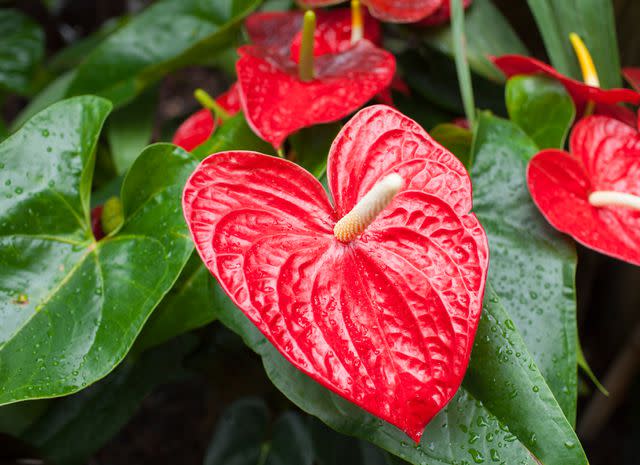
Tim Graham / Getty Images
Anthuriums (Anthurium scherzerianum) are cheery, exotic flowering houseplants with glossy, green heart-shaped leaves topped by heart-shaped pink, red, or white long-lasting blooms. "Happily, anthuriums bloom almost all year long if they get enough light, fertilizer, and moisture," says Hancock. "And if conditions are warm and humid enough, the blooms can last for months."
Size: 18 inches tall x 12 inches wide
Growing conditions: Bright light; well-draining soilless mix
Bromeliads
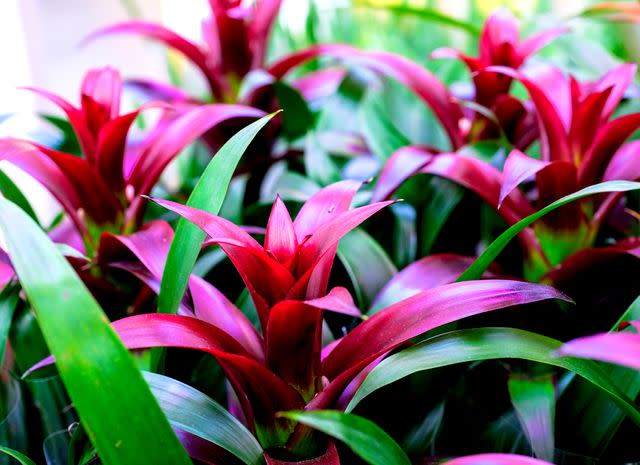
Olga Ostapenko / Getty Images
An exotic plant that adds beauty to your home during winter, bromeliads (Bromeliads) have strappy leaves that are topped by colorful clusters of flowers in shades of red, orange, yellow, pink, purple, or white. "An individual bromeliad plant will only bloom once, but it will produce offshoots that will grow and bloom as they mature," says Hancock. "After the main flower on your bromeliad begins to fade, the mother plant will begin to decline. But you'll see baby bromeliads developing around the base."
Size: 3 feet tall x 3 feet wide
Growing conditions: Medium to bright light; well-draining soil
Oxalis
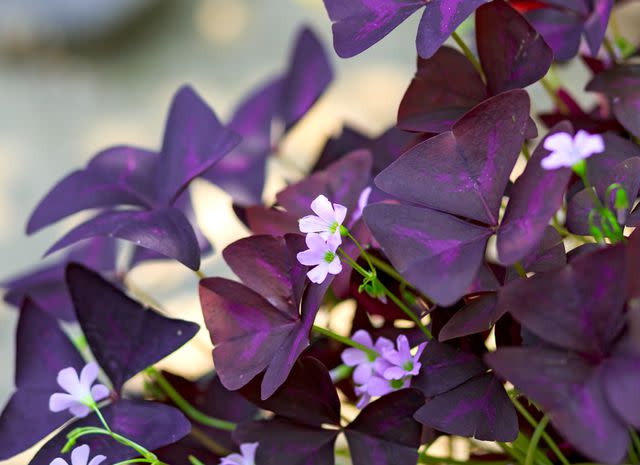
Peera_Sathawirawong / Getty Images
Oxalis (Oxalis spp.), also known as shamrock, has clover-shaped leaves that fold up at night or in low light. The plant will bloom for several months during winter and can be forced into dormancy to manage bloom time. "In late summer slow watering and stop fertilizing and allow it to go dormant. Keep it in a cool, dark place," says Melinda Myers, gardening expert and host of the Great Courses How to Grow Anything DVD series. "Begin watering when new growth appears."
Size: 6 to 12 inches tall x 6 to 12 inches wide
Growing conditions: Bright light; well-draining soil
Clivia
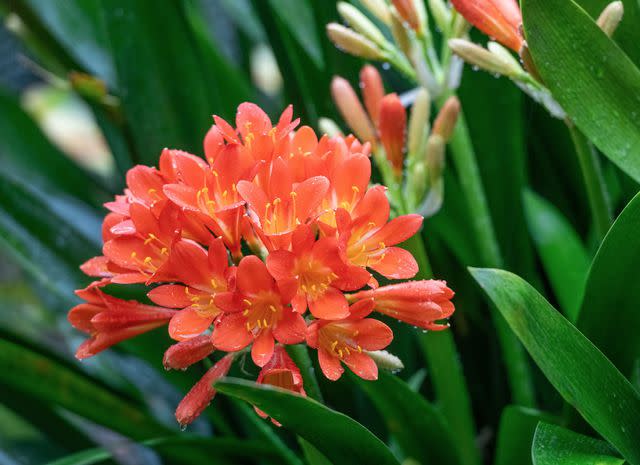
kontrymphoto / Getty Images
Clivia (Clivia miniata) is a rewarding plant that can be challenging to get to bloom, but when it does, it produces fans of strap-like green leaves with umbel-shaped clusters of yellow, orange, and red flowers in winter. The individual flowers only last several days, but the plant blooms for several weeks, says Meyers.
Size: 1 to 3 feet tall x 2 to 3 feet wide
Growing conditions: Bright diffused light; well-draining organic soil
African Violets
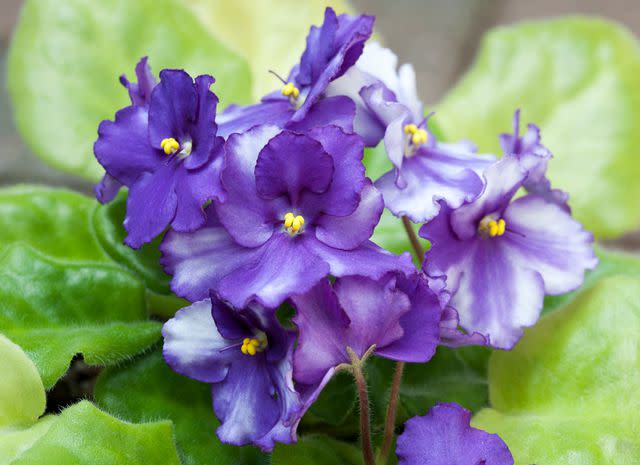
gladassfanny / Getty Images
The flowers on African violets (Saintpaulia ionantha) can last for several weeks any time of the year—including during winter—and can bloom continuously with proper care. The plant has fuzzy leaves with ruffled edges that give way to a rosette of purple flowers.
Size: 2 to 8 inches tall x 2 to 8 inches wide
Growing conditions: Bright light; moist, well-draining soil
Alsobia
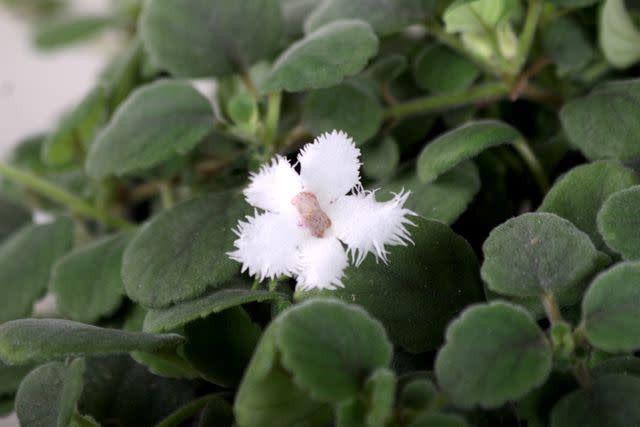
Costa Farms
A relative of African violet, alsobia (Alsobia dianthiflora) has fuzzy green leaves, often with purplish veins, and flowers with white-fringed edges. "Its low-growing form makes it beautiful in planter bowls, as well as hanging baskets," says Hancock. "No special conditions are needed to induce blooms, so it will naturally produce flowers in winter if it gets good light and warm temperatures."
Size: 2 to 8 inches tall x 2 to 8 inches wide
Growing conditions: Medium to bright light; well-draining organic soil
Moth Orchids
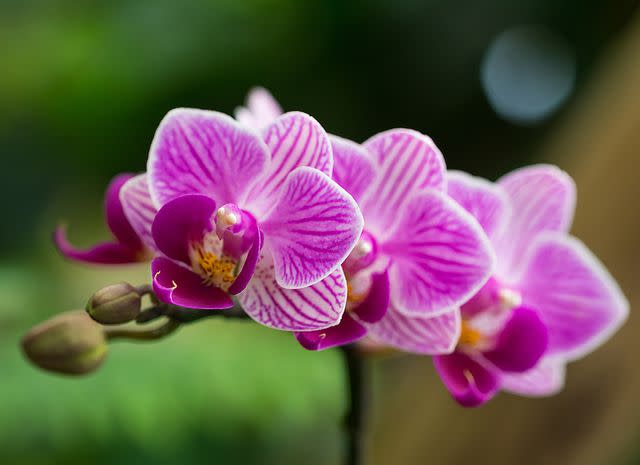
A. Martin UW Photography / Getty Images
Moth orchids (Phalaenopsis orchids) make for fantastic houseplants—even if you're a beginner. "Most have attractive butterfly-shaped (or moth-shaped) flowers, in a wide range of colors, from pinks and purples to apricot, orange, and salmon, to lemon yellow to pure white," says Hancock. "The blooms appear on elegant spikes above the flat leaves that appear in a fan shape." The plant's blooms can last for months when it's well cared for.
Size: 16 to 30 inches tall x 8 to 10 inches wide
Growing conditions: Bright light; orchid mix
Kalanchoe
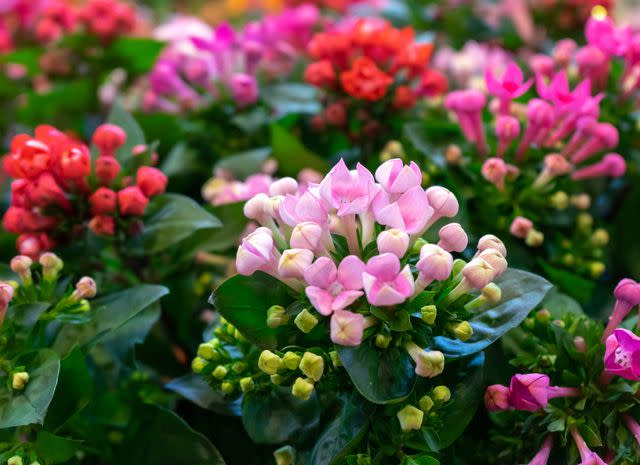
Maksims Grigorjevs / Getty Images
Often sold in bloom from Thanksgiving to Valentine's Day, kalanchoe (Kalanchoe blossfeldiana) has a rosette of thick, succulent, scalloped leaves and flat clusters of small flowers. Get kalanchoe to re-bloom by giving it 14 hours of total darkness, then putting it back in light during the day, says Meyers. Stop the dark period when the buds are fully developed.
Size: 16 to 12 inches tall x 12 inches wide
Growing conditions: Bright light; well-draining soil
Amaryllis
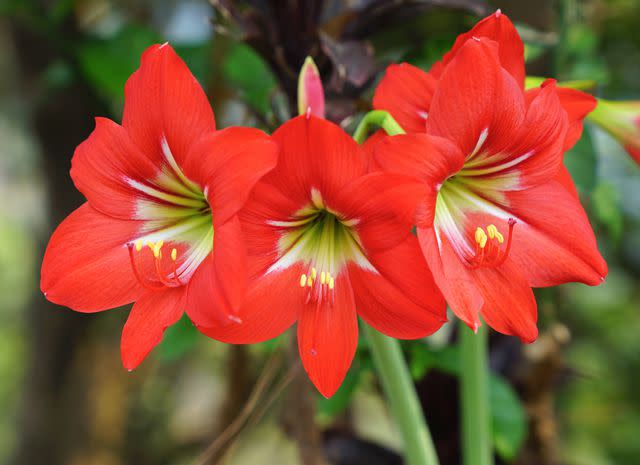
Wanchanta / Getty Images
This beautiful houseplant that is often purchased during the holiday season produces a tall flower stalk with several single or double trumpet-shaped flowers in various colors. Once it's done blooming, allow amaryllis to go dormant by placing it in a dark location. After 12 weeks (or when leaves appear), move it to a bright location and resume care, says Meyers.
Size: 16 to 20 inches tall x 6 to 8 inches wide
Growing conditions: Bright light; well-draining soil
Poinsettia
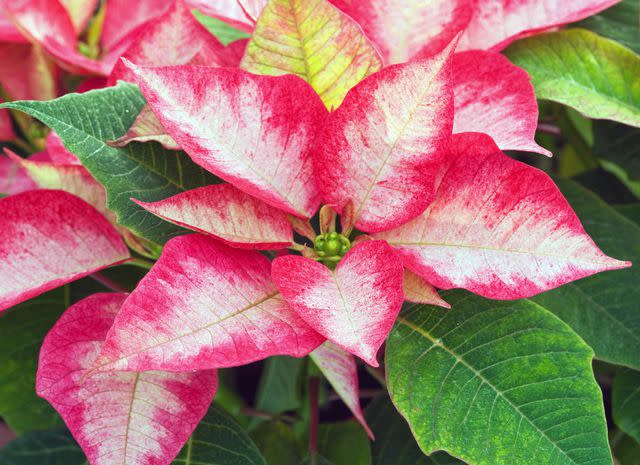
Clive Nichols / Getty Images
One of the most popular holiday houseplants, poinsettia (Euphorbia pulcherrima) is known for its beautiful leaves and small, compact yellow flowers. It is typically purchased already in bloom during the holiday season, but you can encourage it to bloom again next year with proper care. At the beginning of September, give the plant 14 hours of uninterrupted light each night and bright light during the day. Continue for seven to eight weeks, then resume normal care when the bracts (its colorful leaves) begin to show color.
Size: 2 to 3 feet tall x 2 to 3 feet wide
Growing conditions: Bright light; well-draining soil
Bird of Paradise
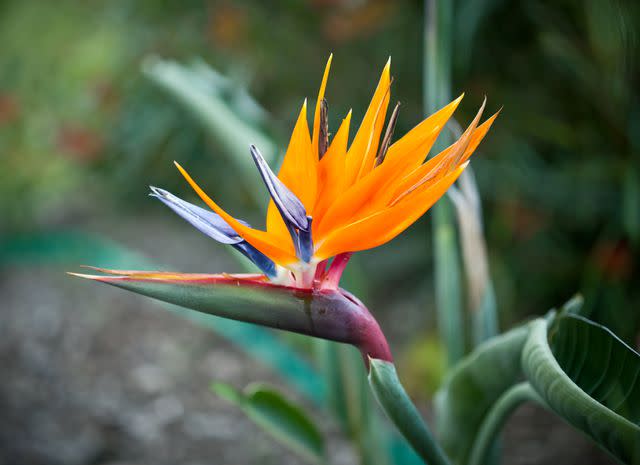
Jenny Dettrick / Getty Images
You'll love seeing this plant in your home come winter. Bird of paradise (Strelitzia reginae) has large elongated leaves and unique flowers that resemble a bird’s head. It can bloom intermittently throughout the year—including during winter—but it must be mature and potbound. Its blooms last for three weeks or more and make great cut flowers, says Meyers.
Size: 3 to 4 feet tall x 3 to 4 feet wide
Growing conditions: Bright light; organic soil that's moist and rich
Related: How to Grow and Care for Bird of Paradise, a Tropical Plant With Stunning, Avian-Like Foliage
Florist Cyclamen
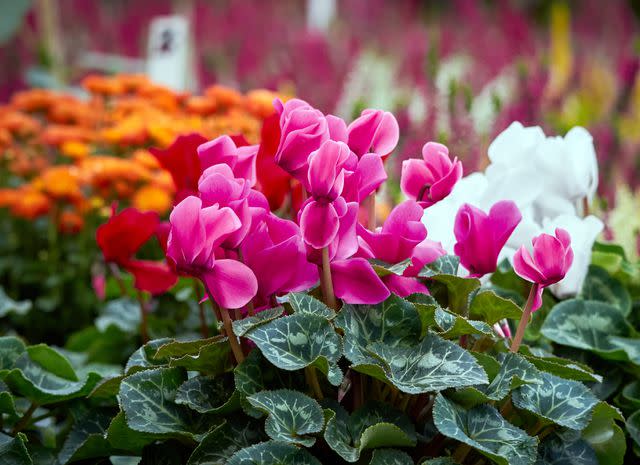
Adrian Eugen Ciobaniuc / Getty Images
Florist cyclamen (Cyclamen persicum) has heart-shaped leaves that form white, pink, red, magenta, or lavender flowers. The downward-facing fused petals are reminiscent of a butterfly. It has a long bloom period that typically lasts for up to three months, from winter through spring. Remove spent flowers to encourage a longer bloom time, says Meyers.
Size: 6 to 9 inches tall x 6 to 9 inches wide
Growing conditions: Bright light; organic soil that's moist and rich
Flame Violet
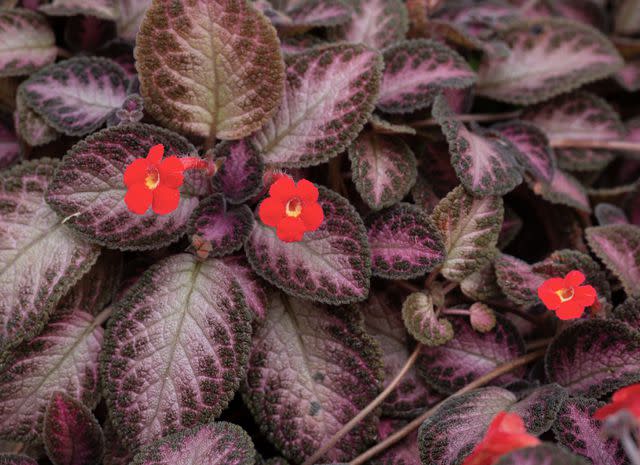
Athichai Chaweesook / Getty Images
Another relative of African violet, flame violet (Episcia cupreata) has attractive flowers and foliage, so it looks beautiful even when it's not in bloom. "Blooms appear in shades of red, orange, and pink," says Hancock. "The fuzzy foliage is often variegated with shades of bronze, purple, pink, cream, or white." You can get the plant to bloom year-round as long as it's given enough light.
Size: 6 to 9 inches tall x 6 to 9 inches wide
Growing conditions: Medium to bright light; potting mix made for indoor plants
Read the original article on Martha Stewart.

